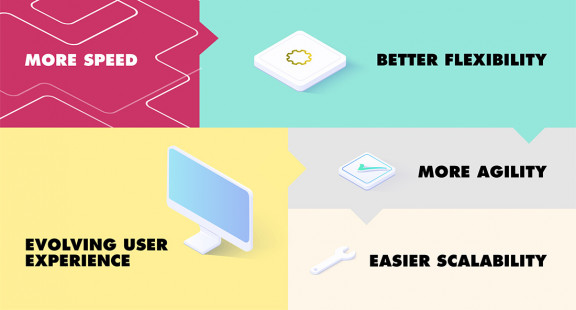
Why should your digital brand turn to a composable set-up?
If your platform creaks under the weight of spikes in traffic, or you are unable to test new features quickly, chances are composable architecture has come up in conversation.
Gartner’s research suggests those that have adopted a composable approach to their architecture will outpace competition by 80 per cent in the speed of new feature implementation - giving them a huge advantage in how they personalise customer journeys, or react to market conditions.
Here, we take a look at composable architecture in more depth and explore five reasons why brands should consider a composable set-up for their digital future.
5 reasons to adopt a composable commerce strategy
-
A composable solution gives you more flexibility
Whether a business wants to test out a different payment solution or content management system, or react quickly to a change in market conditions, a composable tech stack allows it to easily swap out individual components and tailor the site to its requirements. Do you use a lot of content but your search solution isn’t pulling its weight? Simply try swapping it with a best-of-breed search solution like Algolio, to see if it helps with conversions.

While all-in-one solutions can give brands the comfort of having what they need in one platform package, from a developing point of view they come with massive code bases, making even small changes expensive and time-consuming. It can be difficult for developers to work on different parts of the solution at the same time, with lengthy tests of the entire platform needed after the changes are made.
With a composable solution, the architecture is built around microservices which separate different components and services. This allows developers to work on different sections of the site simultaneously and gives a brand the flexibility to be reactive and pro-active in changing functions that best suit their needs, when required, without affecting other areas of the site.
-
A composable solution allows you to continually evolve the user experience
With content and personalisation now integral to a digital brand’s growth and success, composable architecture allows brands to quickly change and adapt strategy as necessary.
With a monolithic solution, the front-end code is tightly coupled with the back-end code, meaning small or constant changes to the front-end require changes to the back and significant testing. However, decoupling the front-end from the back-end, solves many of these issues. Best-of-breed components therefore allow businesses to have a much greater say in what they do and how they do it, taking the customer experience to the next level.
Composable architecture gives brands the opportunity to maximise their data and real-time feedback to give customers a true omnichannel solution with a focus on personalisation. This enables businesses to innovate and deliver content where and when it’s needed, in-line with business decisions and market changes, without disrupting other parts of the set-up.
-
A composable tech stack means you can pivot your business strategy quickly
From the pandemic and war, to a cost-of-living crisis, the past few years have shown how volatile supply chains and markets can be.
Businesses understand the importance of agility and being able to pivot business strategy quickly - and composable architecture gives digital retailers the tools to ensure their operations are better prepared for all eventualities.
A digital retailer may struggle to keep up with the ever-changing demands of its customers or market volatility if it’s always rushing to develop a brand-new experience for every digital shopping channel at the speed it needs to.
By using best-of-breed components and building a flexible tech stack, it can build a library of individual applications that suit different needs and eventualities, some of which are not even being used all the time. This allows components to be swapped in and out much more frequently and easily without massive site overhauls.
-
Composability means faster everything
A composable tech stack allows brands to constantly test and learn, putting innovation at its core. Gone are the days of hanging around for developers to create and test new features; now new applications can be highlighted, trialled and swapped with ease – and the ones swapped, reused, rather than businesses throwing away months of coding and hard work.
Developers can also optimise individual components for speed, leading to quicker sites, full-stop. This allows developers to pinpoint and fix bottlenecks quickly, or even replace services with a faster service that better suits its needs.
Any other platform issues can also be isolated more easily, meaning they can be fixed quickly while the rest of the site operates normally.
-
Composable solutions offer better scalability
When Lego’s e-Commerce site buckled under the weight of traffic during a set launch in 2017, it managed seven orders per second. With a composable solution in place, it launched one hundred new products and saw huge spikes in traffic, but processed two thousand orders per minute, without any issues.
Composable architecture allows for better scalability, meaning businesses can ease or negate spikes in traffic without increasing servers.
Brands can scale individual services up or down independently of others, allowing developers to optimise solutions for peak traffic periods, but act reactively to un-foreseen spikes and dips.
Businesses can explore best-of-breed cross-channel order management services that fit in with their unique business and with a multi-cloud approach, teams can share workloads across data centres and private clouds seamlessly.
With an infrastructure that is easier to scale, brands are more flexible to grow as demand grows, or vice versa.

5 top benefits of composable commerce
A composable set-up offers digital businesses many benefits that an all-in-one solution may not.
These include:
-
Better flexibility. Swap different applications in and out in-line with business or market needs.
-
More agility. Be prepared for the ‘next pandemic’ with separate applications that you can store for different scenarios.
-
An evolving user experience. Ensure your business is reactive to customer needs by testing and innovating more easily.
-
More speed. Try different features faster and optimise different components for a quicker digital experience for customers and business.
-
Easier scalability. Be better prepared for spikes in traffic.



